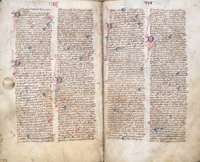 |
 |
 |
 |
 |
 |
 |
|
Byland Abbey: History
Byland Abbey: Buildings
|
Health care at Byland There are four winds. There are four ranks of angels in
heaven.
The infirmary at Byland, like that of other religious houses, was managed by the infirmarer (or server of the sick), who was a monastic official (obedientiary) of some prominence. He would have had at least one servant to assist him. In addition to sick monks, the infirmarer would have cared for those recuperating from bloodletting, as well as older members of the community who required greater comfort and a more fortifying diet. The twelfth-century
customary of the Cistercian Order (Ecclesiastica Officia) discusses
the infirmarer’s managerial duties in some detail, but says
little of his medical knowledge. The infirmarer – and no doubt others
in the abbey – was probably well-versed in herbal remedies and used
herbs from the abbey’s herb garden. The infirmarer would
have had access to certain medical and herbal texts from the library at
Byland. An interesting example is a late twelfth/early
thirteenth-century
herbal now preserved in Cambridge University Library. This rather ambitious
work began as an exhaustive list of herbs in alphabetical order, but stops
at the letter ‘B’; it then continues with a summary of humorology
and its bearing on bloodletting. For example, it recommends that bloodletting
should not be carried out after the Ides of July, as blood was most active
just before this period.(55) |
